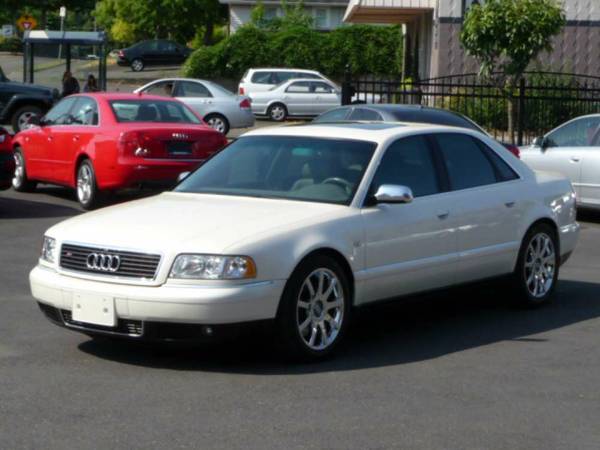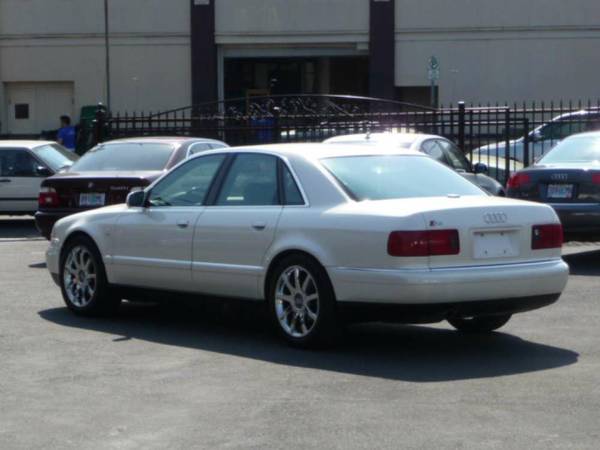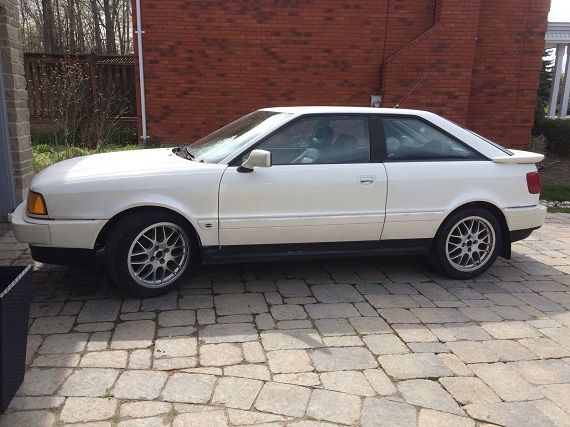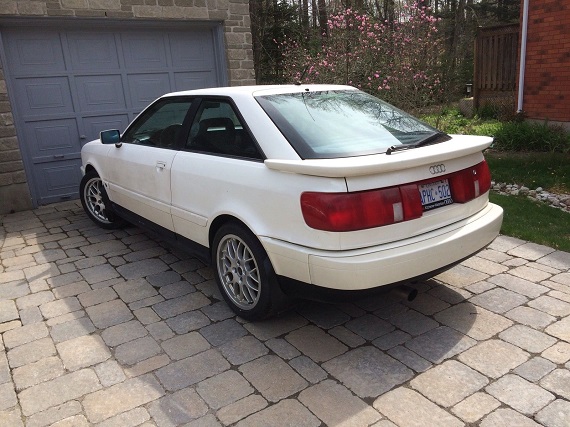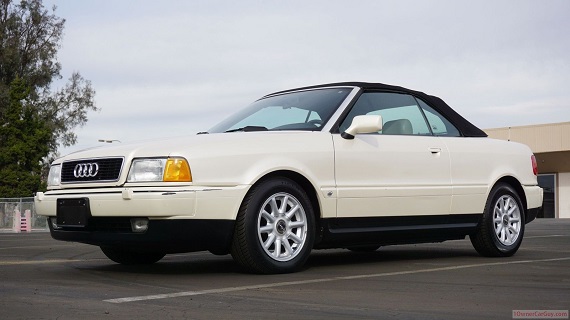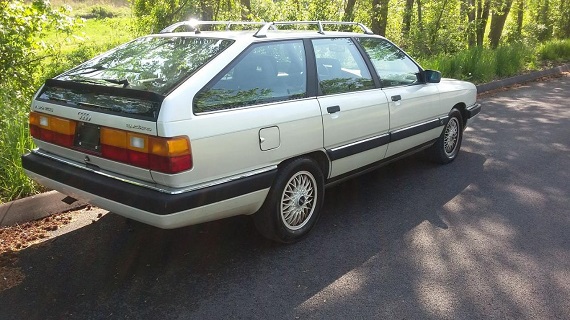Looking at the outrageous B5 and B6 S4s from yesterday is a stark reminder of how far the company has come from the rather humble roots of Audi’s small chassis. Sure, the B2 was the basis that launched the new direction for the company in the Quattro, but most B2 cars were modest, relatively underpowered near luxury cars. Park one next to a new A4 and you’ll be amazed at just how large they’ve become; from a 100 inch wheel base, 66 inch width and 176″ overall length, the B2 tipped the scales at a little under 2,400 lbs in 1980. The new A4s have a foot more in between the wheels (and the ends of the bumper, no surprise there), are half a foot wider and are half again as heavy at nearly 3,800 lbs for the sedan. Brakes are now the size wheels once were on even the standard A4s, and horsepower? Well, the lowly 2.0T carries more punch than the original Quattro did in all but 20 valve and Sport form, even in European trim. While cars have gotten better at being cars than they once were, they’ve also become smart phones, offices, relaxation oases and sports arenas. Cars start, drive, and park themselves, tell you how to get places and when you’ll get there, and even will tell Big Brother what you did wrong when you get into a accident. It’s somehow a loss of innocence which makes contemplation of simpler times so appealing, and looking at this 1988 Audi 90 quattro is just that. So let’s pop your copy of “Die Hard” in to your VCR, adjust the tracking and take a glimpse into Audi’s past:
Tag: pearlescent white metallic
This site contains Ebay partner affiliate links, which may earn us a commission at no additional cost to you.
2002 Audi S8
In many ways, to me the D2 S8 is the last of the great 1980s Audis. But wait, you say – it wasn’t built in the 1980s. It may have shared little design with the original Quattro other than the drivetrain layout and the Vier Ringe on the grill, but at its heart the S8 was the culmination of the mission of the original car – to cover ground at high speed in a luxurious 4-seater regardless of the weather conditions. Now, truth told newer Audis are bigger, badder and faster. Some even look better, though not many in my eyes. They have more technology, power and luxury than ever. So, it would be natural to say that they, too, accomplish the mission of the Quattro – and they do. But, the essence of what was Audi somehow was lost along the way. The D2 S8 didn’t sell in great numbers, but that wasn’t because it was the most expensive option and it certainly wasn’t because it was unattractive or slow. Perhaps it lacked the raw driver connection of cars like the contemporary E39 M5 and the physical grunt of the AMG E55 and S55 models. But as an all around package, the S8 is surely one of the best Audis produced. It’s quick, driver oriented, supremely comfortable, all-weather capable and even (dare I say) reliable relative to other VAG packages. It’s not so tech-heavy that it feels outdated the moment you step in the cabin; rather, it feels like the most up-to-date version of the C4 chassis and that’s generally a good thing. It sounds great, too, thanks to the silky smooth V8 under the hood. The only downside is that with low residuals, locating a really nice one any day of the week is not nearly as easy as finding a clean M5:
CLICK FOR DETAILS: 2002 Audi S8 on Boulder Craigslist
10 Comments1990 Audi Coupe quattro
Nomenclature has been something Audi fans have struggled with, but to be fair the naming scheme from Ingolstadt hasn’t always been particularly straightforward. For example, though ubiquitous as the Coupe GT, there was actually a trim and performance difference between B2 front drive Coupes and Coupe GTs. Similarly, though U.S. fans often fair to recognize it, the B3 Coupe quattro was actually the second Coupe quattro; Europeans enjoyed the option of having a non-turbocharged, non-flared version of the B2 platform which few but the most dedicated U.S. Audi Coupe fans are aware of. Then there’s the name – properly, a capitalized Quattro refers to the aforementioned legend – the model that launched the branding of Audi’s all-wheel drive system. Every subsequent model that followed properly has a lowercase “q” if it sported the optional all-wheel drive. That even goes for models that were only offered in all-wheel drive, such as the V8 quattro. So confusing is the naming scheme that fans have taken to using “Ur” to refer to the Quattro (though proper capitalization would take care of the problem) for not only the original model, but the C4 S4/S6 and I’ve even been seeing it used for TTs, A4s and a few others. But the B3 and B4 Coupe wasn’t just offered in all-wheel drive; there were a long line of optional engines in the Coupe in both two and four wheel drive. However it only came to the U.S. in one configuration – the under appreciated 7A inline-5 20V motor pushing all four wheels. The B3 ran the second generation of quattro, with the center differential controlled by a Torsen unit and the rear open with an optional, speed limited locking unit. It upped the safety and electronic options to respond to market demands. They were heavy with electronic features including power seats, and passengers enjoyed the confusing safety net known as PROCON-10 – essentially, a series of cables which pre-tensioned seatbelts in the event of a crash. Though the production run of U.S. Coupes was brief at only 2 years and roughly 1700 units, there were many changes over that time. The motor changed ISV valves and computers as well as swapping from a tubular header to a cast iron unit. Shortly into production, airbags became standard on both the Coupe and sedan models. A rear swaybar was added, along with changes to the hydraulic system. All of these went relatively unseen to consumers, making the only notable change the addition of a glass sunroof to 1991 models. For the most part, these cars came fully loaded with the only options being Pearlescent White Metallic paint and power heated seats, unlike the sedan which despite being fewer in number has much more variety in options. This 1990 example was basically as expensive as a B3 got here:
CLICK FOR DETAILS: 1990 Audi Coupe quattro on eBay
3 CommentsEvery semester at the culmination of my teaching experience with the college students who have selected my course rather innocently, I let them in on my super-secret double agent identity as your author here. Having suffered through a few too many of my lectures already, most treat the news with about the same amount of enthusiasm and interest as they do when I tell them about the Sudanese Kush Pharaohs – which is to say, none (seriously, it’s a very interesting topic. Egypt basically denies they existed!). But occasionally I get a student who is much more interested in my double-life than in my lecture notes. One such student passed through was perhaps as unexpected to me as I was to him. He nonchalantly aced the class with seeming little difficulty, but upon seeing my announcement regarding German Cars For Sale Blog, he excitedly emailed me about his shared love of Audis. He revealed that he owned a ’97 Cabriolet, which proves two things: first, smart people buy Audis, and second, Audis turn up where you least expect them. And the Cabriolet might be the least expected Audi Audi made – coming from a manufacturer renowned for turbocharged inline-5, manual all-wheel drive coupes, sedans and wagons came a front-wheel drive, automatic only (in the U.S.) V6 2-door convertible. Expensive, a bit slow and soft compared to the competition, the Cabriolet sold slowly with only around 1,000 units moved per a year during its availability here with a total of 5,439 imported through 1998. I think a fair amount of fans view the B4 Cabriolet as the least interesting of the Audi lineup in the 1990s, but to me it’s always been a very pretty and underrated car. In particular, the rear 3/4 view is very attractive and the shape changed little with its progeny. But the unusual nature of the Cabriolet has generally meant that it’s been a pretty big bargain in the used convertible market for the past few years – if you can find a good one:
CLICK FOR DETAILS: 1996 Audi Cabriolet on eBay
1 Comment1990 Audi 200 quattro Avant
Although the C3 Audi chassis enjoyed a reasonably long production run of 1984-1991, each year introduced changes that, while evolutionary, were notable and make each specific model year feel a little bit bespoke. The biggest change was the 1986 introduction of Audi’s all-wheel drive system of quattro to the large model range, making three distinct packages you could get the unique drivetrain in the luxury market. In the U.S. market, 1986 5000 quattros came only in “CS” spec and sedan – basically, fully loaded with only heated seats, Fuchs forged wheels and Pearlescent White Metallic paint as options. 1987 opened the options, but not with more gadgetry – the Avant, previously only available in front drive normally aspirated “S” form, joined the quattro lineup full time after being introduced about halfway through the 1986 model run. Alcantara also became a seldom-selected option. 1988 saw a very minor revision to the turbocharged “CS” models with new script badges in the rear and a few more options including heating for the rear seats and Velour interior options, but the big news was a new “5000S quattro” model, which came sans turbo and without the twin-bulb headlights, but shared the big brother turbo brakes and wheels. It was a smart move to drop the price on the quattro models, as the normal run 5000 reported outsold the 5000CS quattro by a measure of 4:1! 1989 was highlighted by a complete model refresh, moving to the European “100/200″ model designations. Accompanying the change were some new colors and minor alterations, such as more upscale-looking 15″x6” BBS wheels (color matched on Pearlescent White Metallic examples, just as the aero and Fuchs wheels had been). But inside an entirely new sweeping dashboard setup would be the standard on big Audis for the next 7 years. Instead of the previously confusing “S/CS” monikers, turbocharged models now wore the 200 badge, while normally aspirated models were 100s. The Alcantara and Velour options disappeared on the 200 models, which came only fully-loaded, and Fuchs were no longer an option. The 100 quattro shared many components with the 80/90 quattros from the same time, including the NG normally aspirated motor instead of the turbocharged MC1. 100s also ran the familiar small-chassis 4×108 bolt pattern with accompanying smaller brakes, but oldly Audi commissioned BBS to make a run of 15″x6″ wheels that matched the look of the 200’s wheels outwardly. Mechanically, otherwise there were few changes to either model, though as with the 80/90 quattros, the option to lock your own differential was now limited to the rear, and then speed limited to 15 m.p.h.. While 1990 saw few changes to the run overall, there was a change in motor in the 200. A rolling change saw the revised (and very short lived) MC2 replace the MC1. Twin knock sensors allowed engineers to run higher compression; coupled with a reground camshaft, lighter mass flywheel and smaller K24 turbo meant that the MC2 could run less boost and spool more quickly for a better driving experience, but ultimately the facts and figures say the power was unchanged. As always, top of the heap was the 200 quattro Avant, and they didn’t get any more expensive than when optioned with the Pearlescent White Metallic paint:


